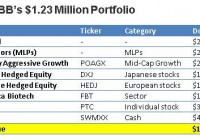5 Aggressive Growth Mutual Funds To Buy For High Growth
When capital appreciation over the long term takes precedence over dividend payouts, growth funds become a natural choice for investors. However, investors looking for highest capital gains should look no further than investing in aggressive growth mutual funds. These funds invest in companies that show high growth prospects, but that comes with the risk of share price fluctuations. This category of funds also invests heavily in undervalued stocks, IPOs and relatively volatile securities in order to profit from them in a congenial economic climate. Securities are selected on the basis of their issuing company’s potential for growth and profitability. Below we will share with you 5 buy-rated Aggressive Growth mutual funds. Each has earned a Zacks Mutual Fund Rank #1 (Strong Buy) or Zacks Mutual Fund Rank #2 (Buy) as we expect these mutual funds to outperform their peers in the future. Hartford Growth Opportunities Fund A (MUTF: HGOAX ) invests in a broad range of common stocks from diversified industries and companies that the sub-adviser considers to have superior growth prospects. HGOAX focuses on mid to large cap stocks and a maximum of 25% may be invested in non-US issuers and non-dollar securities. HGOAX has a three-year annualized return of 21.6%. Hartford Growth Opportunities A has an expense ratio of 1.15% compared to a category average of 1.19%. Fidelity Growth Strategies (MUTF: FDEGX ) seeks capital appreciation. FDEGX invests primarily in common stocks of domestic and foreign issuers that the management believes offer potential for accelerated earnings or revenue growth. FDEGX focuses on investments in medium-sized companies, but it may also invest substantially in larger or smaller companies. FDEGX has a three-year annualized return of 21.1%. As of May 2015, FDEGX held 123 issues, with 2.41% of its total assets invested in Avago Technologies (NASDAQ: AVGO ) PrimeCap Odyssey Aggressive Growth (MUTF: POAGX ) invests in U.S. companies having rapid earnings growth potential. Though POAGX invests across market sectors and market caps, it has historically invested most of its assets in mid to small cap firms. This high yield mutual fund has a three-year annualized return of 8.7%. POAGX has a three-year annualized return of 25.3%. Theo A. Kolokotrones is the fund manager and has managed this fund since 2004. Vantagepoint Aggressive Opportunities Fund (MUTF: VPAOX ) seeks capital growth over the long term. It invests using an actively managed strategy in stocks of small to mid cap domestic and foreign firms, which are believed to have high capital growth prospects. The fund also invests in stocks listed in a custom version of the Russell Midcap Growth Index. VPAOX has a three-year annualized return of 25.3%. Vantagepoint Aggressive Opportunities Investor has an expense ratio of 0.83% compared to a category average of 1.30%. ClearBridge Aggressive Growth Fund A (MUTF: SHRAX ) seek capital appreciation. SHRAX invests in companies that the manager believes are growing or will improve earnings at a faster rate than companies included in the S&P 500 Index. SHRAX invests a significant portion of its assets in small and medium-sized companies. SHRAX has a three-year annualized return of 21.9%. As of June 2015, SHRAX held 71 issues, with 9.3% of its total assets invested in Biogen Inc. (NASDAQ: BIIB ) Original Post
